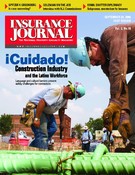The U.S. property/casualty insurance industry showed continued favorable and improved operating performance in the first half of 2006 and, based on results and barring any unusual events going forward, the industry is likely to meet or exceed Fitch Ratings’ estimates for underwriting performance and net income for the full-year.
“Fitch recognizes that results in the second half of 2006 are unlikely to match the impressive year-to-date results, due to the seasonality of U.S. windstorm activity, most of which typically takes place in the third quarter,” said James Auden, senior director, Fitch Ratings. “However, if insured catastrophe losses in 2006 return nearer to historic averages, the industry is poised to post strong underwriting profits for the full year.”
Specifically, the 2004 and 2005 hurricane seasons revealed the potential for greater frequency and higher severity of insured losses related to natural catastrophes. Fitch believes that this realization will continue to affect pricing and reinsurance availability in catastrophe exposed lines for the foreseeable future.
While mid-year statutory results are not fully available, Fitch also has compiled GAAP earnings release and 10-Q filing data from publicly traded property/casualty insurers in its debt rating universe, as well as several other insurance organizations of interest, to evaluate first-half 2006 performance. The overall results for this subject group show improvement over the comparable prior period in underwriting results and profitability.
Roughly two-thirds of the organizations in the Fitch group reported improved underwriting results during the first half of the year.
Fifty-one of the 53 insurers reported an underwriting profit for first-half 2006, compared with 48 of 53 in the year-ago period. Fitch said it believes these favorable results reflect a still adequate overall rate environment, an absence of unusually large catastrophe losses during both periods, and a trend of diminishing adverse loss reserve development, particularly for the 1997-2001 accident years.
Additionally, Fitch’s group of 53 property/casualty organizations had combined earned premium revenue of approximately $124 billion during the first half of 2006, an increase of 2.1 percent from the prior-year period. Earned premium revenue growth continues to gradually decline due to mostly flat or declining insurance rates in non-catastrophe-exposed business lines.
Reinsurers
Among individual (re)insurers, there was a marked consistency of results during first-half 2006, with combined ratios mostly in the high 80 percent to low 90 percent range and operating returns on equity in the mid-to-high teens.
This general trend excludes the property reinsurers, which, perhaps not surprisingly, posted stellar underwriting results and profitability, due to seasonally light catastrophe losses during the first half of the year. Notably, this sub-segment outperformed Fitch’s larger universe during first-half 2005 as well, before record catastrophe losses in the second half of the year led to average combined ratios in excess of 200 percent and net losses for the four reinsurers in this sub-segment.
Other reinsurers in Fitch’s universe posted generally favorable first-half 2006 underwriting results and profitability that were more in line with the larger Fitch universe’s average results. These reinsurers saw underwriting results largely unchanged year over year with an average combined ratio of 90.2 percent.
Operating and net returns on equity for this group were modestly higher year over year, at 17 percent and 20 percent, respectively. The larger, diversified insurers generally posted very favorable underwriting results, with combined ratios for most companies ranging from the mid-80 percent to low 90 percent range, similar to this sub-segment’s results in the year-ago period.
Regional insurers
The regional insurers posted underwriting results that were largely unchanged from the prior-year period, with combined ratios generally in the mid-to-high 90 percent range. The underwriting results for this group underscore a key disadvantage they face relative to their larger competitors. While average loss ratios for regional underwriters of 61.4 percent were better than the average result of 62.1 percent for their larger, diversified competitors, the average combined ratio for regional insurers was roughly six points higher than the larger, diversified sub-segment. The difference resulted from higher expense ratios for regional carriers due to scale disadvantages.
Specialty commercial insurers
The specialty commercial insurers posted overall favorable underwriting results, year-to-date. Combined ratios were mostly in the mid-80’s to low-90’s, and 12 of 14 organizations saw their combined ratios improve year over year. The group’s average loss ratio of 57.2 percent was roughly five points better than the larger, diversified companies. All of the specialty insurers in Fitch’s universe posted an underwriting profit for the first half of the year with the exception of PMA Capital.
Personal lines
Each personal lines insurer in the group posted an underwriting profit for the first half of the year, with an average combined ratio of 90.5 percent that was roughly a half-point higher than the year-ago period. Notably, the personal lines insurers were the only sub-segment to see average net and operating return on equity’s decline year over year, although the drop-off was fairly modest. Going forward, competitive pressure is likely to promote continued deterioration in personal lines writers’ results.
Topics Catastrophe Carriers Profit Loss Underwriting Reinsurance Property Casualty
Was this article valuable?
Here are more articles you may enjoy.


 Expense Ratio Analysis: AI, Remote Work Drive Better P/C Insurer Results
Expense Ratio Analysis: AI, Remote Work Drive Better P/C Insurer Results  Update: Verizon Says Service Restored After Thousands Affected by Outage
Update: Verizon Says Service Restored After Thousands Affected by Outage  Business Moves: ALKEME Expands in US With Addition of 5 Agencies
Business Moves: ALKEME Expands in US With Addition of 5 Agencies  Florida Heads for Smallest Orange Crop in Nearly a Century
Florida Heads for Smallest Orange Crop in Nearly a Century 


